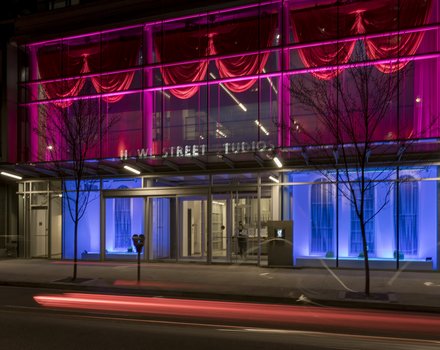

Oscar Valero Saez “In a Landscape”, Oscar Valero Saez
C$ 0.00 Excl. tax
- File number: EXHI1031
...
Using John Cage’s composition In a Landscape as a starting point, Valero Saez’s exhibition investigates the transportation of the viewer into the musical text. The relationship between the act of listening and the act of viewing is considered when the music begins to intrude onto the visual world. This work is an extension to Valero Saez’s alphabet series, which are two dimensional images tracing the three dimensions of braille.
In a Landscape is a research project around the figure of John Cage and the origin of sound-based Conceptual Art in the New York School. Written music is used as a strategy to explore the notion of art as a process and open structure, where a score takes on more importance as a visual work than as a conventional musical notation.
In a Landscape begins with the transcription of the musical language to computer code through a mechanical piano roll. Topographic parameters and base-mapping are obtained to build a three-dimensional piece. It illustrates the space where music collides with the visual world, evoking the state of being in two worlds at once, creating an artificial synesthesia.
Synesthesia is a neurological condition in which stimulation of one sensory or cognitive pathway leads to automatic and involuntary experiences in a second sensory or cognitive pathway. Synesthesia is also sometimes reported by individuals as a result of blindness or deafness.
This project investigates how to encourage a visual awareness of an auditory experience. On entering the space and interacting with the piece, the visitor’s visual curiosity may be unaccustomed to this kind of visual listening.
The exhibition is a physical action within the context of John Cage’s piece, emphasizing the corporeal nature of listening and invoking a space in which the music becomes the background upon which all things rest. The narrative becomes real because the viewer has taken up residence within the piece. Concepts originating in sound are explored in architectural terms.
Through a combination of sound, media, and work on folded paper (origami sculpture), this project creates a sort of abstract sculpture that will enable people to understand John Cage’s piece in a visual way.
In its first stage, two parameters of the sound have been analyzed: pitch and time. These parameters have been entered onto a mechanical piano roll score.
The visual result is a continuous roll of paper, monochromatic with holes of different length that represent the musical notes. The rows and columns are according to the duration of the musical piece. In this net, the x-axis represents time and the y-axis represents tone-frequency.
The tone (high or low) is associated with two spatial components: location and length. The high pitch tone is located at the top of the y-axis with a short length, and the low pitch at the bottom of the y-axis with a long length.
The length corresponds to the pitch of the note and is placed perpendicular to each node. Treble tones are short and bass tones are longer. The result is a three-dimensional cartography piece, which is the support for building the sculpture of folded paper.
The nodes act as a supporting structure for the musical notes, rewriting the musical piece into a new three-dimensional visual space.
The installation of In a Landscape works as a dynamic organism layering diverse channels of information and creating relations between them. Transitioning between sound and image, the exhibition explores alternative perspectives that seek to develop an understanding of that which we do not fully comprehend.
In a Landscape by John Cage was written for the dancer Louise Lippold in 1948. It premiered in Black Mountain, North Carolina on August 20, 1948. The length is 8 minutes and the piece may be played on the harp or piano. The piece is similar to Cage’s “Dream.” The structure of the piece follows the rhythmic patterns of the choreographed dance for which it was composed.
A modal composition, the patterns alternate between a mode in B and a mode in G. With the use of both the soft and sustain pedals, Cage creates music that seems to suspend time. The sound of the composition is soft and meditative, reminiscent of the music of Erik Satie. It has the perfect symmetry of Cage’s invention and structural rhythm. The structure is 15 x 15 (5+7+3), meaning that the piece contains 15 parts, of 15 measures each. Each part is divided into 3 phrases: 5 measures, 7 measures, and 3 measures.
The 15 parts as a whole are divided into three large sections in the same proportions.
Curated by Justin Muir, Executive Director
Oscar Valero Saez (Madrid, 1977) is an artist and architect based in Madrid, Spain, and is currently living in Vancouver.
He completed a bachelors degree in architecture from the Universidad Politécnica in Madrid and a masters degree in graphic arts from the Foundacion CIEC (Centro Internacional de la Estampa Contemporánea) in A Coruña.
His practice is multidisciplinary and encompasses architecture, painting, copperplate etching, xylography, and lithography. He has worked collaboratively in studios and workshops such as the Circulo de Bellas Artes (Fine Arts Circle) in Madrid, Spain, and currently at Malaspina Printmakers in Vancouver, Canada.
Saez received the Maria de Salamanca first prize at the XVIII National Engraving Awards through the Museum of Spanish Contemporary Engraving in Málaga, Spain.
Exhibitions include Graphic work Oscar Valero Sáez 2009 – 2011, Foundacion CIEC (Centro Internacional de la Estampa Contemporánea), A Coruña; El arquetipo del Paisaje Sala de Exposiciones Al Artis, en Alalpardo, Madrid; Pasabas, te estabas yendo, Círculo Mulier, Madrid; and, The colour from black and white, en la Galería MA Bretagne, Madrid.
Recently viewed
-
 Favoriten
Add to cart
Favoriten
Add to cart
Oscar Valero Saez “In a Landscape”, Oscar Valero Saez
C$ 0.00 Excl. tax


